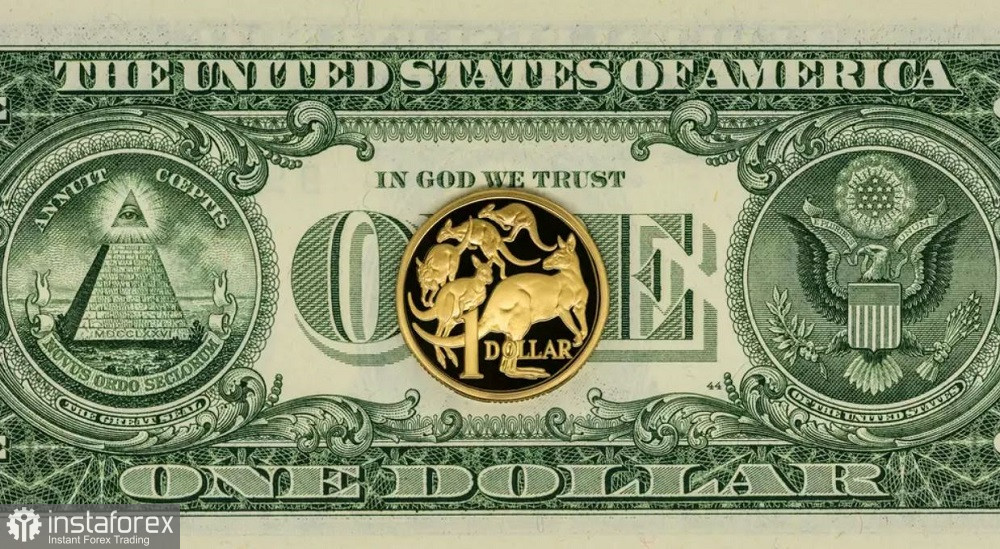The Australian dollar, paired with the US currency, is actively losing ground this week.
For the first time in the last three weeks, bears of AUD/USD intercepted the initiative and caused a reversal. As a result, the pair dropped to the area of the 64th figure.

Let us focus on the weekly chart. During most of February, the price was moving slowly upward with deep pullbacks. However, this week, bearish sentiment prevails in the pair. This is mainly due to the strengthening of the US currency. The US dollar index has been consistently rising for the fourth consecutive day. Despite the significant southern pullbacks, the index is steadily moving upward. However, the downward dynamics of the AUD/USD pair could be explained by the weakening of the Australian dollar. The January report on inflation growth in Australia added fuel to the situation. Meanwhile, traders ignored the PCE core index, although it reflected the slowdown of inflation in the US.
Let's start with the Australian statistics. According to the data released this week, the consumer price index remained at 3.4% in January. The release came out in the "red zone," as most analysts expected the CPI to rise to 3.6%. The index was consistently declining since last October, but, as we can see, the downward dynamics stopped in January. On the other hand, fears about the acceleration of monthly inflation did not come true. After some deliberation, traders interpreted this contradictory report not in favor of the Australian dollar. In addition, another report, namely, retail sales, came out in the red zone. Thus, in January, retail sales in Australia increased by 1.1% m/m, while most analysts had expected a more significant rise in the indicator—by 1.5% m/m.
However, it should be recognized that these releases only added to the overall fundamental picture and did not play a decisive role in the pair's decline. The Australian dollar is under pressure from a general fundamental background. The fact is that recently more and more people started to say that the Reserve Bank of Australia will start easing monetary policy in the second half of this year, despite hawkish signals from the central bank. Thus, according to economists at TD Securities, the RBA will cut the rate by a total of 100 basis points. The first round of cuts should take place at one of the autumn meetings, probably in November.
According to the results of a Bloomberg poll, the Reserve Bank will start cutting the rate earlier, that is, in the third quarter of this year. The results of the previous poll showed that most of the respondents consider Q4 to be the most likely period of the key rate cut. At the same time, experts expressed confidence that inflation would reach the upper limit of the central bank's target range of 2-3% in the fourth quarter. That is, respondents expect the RBA to lower the rate even before the consumer price index reaches the limit of the target range.
In this context, it should be noted that at the end of Q4, Australian inflation grew by 4.1% in annualized terms, with a forecast of 4.3%. The index has been demonstrating downward dynamics for the fourth consecutive quarter. On a quarterly basis, the index also came out in the red zone, being at 0.6% against the forecast of 0.8%. This is the lowest value of the index since the first quarter of 2021. Australia's unemployment rate in January hit a two-year high, rising to 4.1% instead of showing a 4.0% increase. This is the highest reading since January 2022. The number of employed persons increased by only 0.5 thousand, while analysts had expected growth of 26 thousand. In December, this indicator also came out in the red zone as the number of employed decreased by 62 thousand against an anticipated rise of 15 thousand.
All this suggests that at the next RBA meeting scheduled for March 19, the regulator may soften its position or, at least, remove from the text of the accompanying statement words that the central bank may raise interest rates. This step will be quite enough to boost pressure on the Australian dollar.
In general, the current fundamental background favors a further decline in the AUD/USD pair. The greenback's position is quite confident against the background of weakening dovish expectations. The market is confident that the Fed will keep the interest rate unchanged this month, and it is almost certain that it will maintain the status quo in May (the probability of a rate cut is only 25%). The probability of monetary policy easing in June is only 51%.
From the technical point of view, the pair on the daily chart is between the middle and upper lines of the BB indicator, as well as under all the lines of the Ichimoku indicator (including the Kumo cloud), which has formed a bearish signal. The first and so far the only target of the downward movement is 0.6450, the lower line of Bollinger Bands on D1. In this area, it is advisable to take profits and take the wait-and-see approach.





















